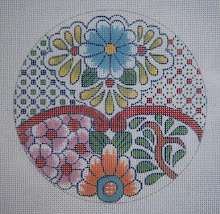 For someone who didn't want to paint canvases any more, I'm certainly doing a lot of it. (the fish is my latest madness in the Mexican Talavera line)
For someone who didn't want to paint canvases any more, I'm certainly doing a lot of it. (the fish is my latest madness in the Mexican Talavera line) Lest anyone think I've gone to join my ancestors, lost interest in pontificating and enlightening via my blogs, lost my mind, or just been too lazy to do any new posts, I 've actually been busier than usual. I've been re-writing two of my books that I did several years ago that I think need refreshing - and also put into E-Book form for sale on the web page (Elegant Whimsies).
 The PLAID is one of my favorite "special effects with simple materials," and I've been doing it for personal projects since about 1973, when I first started playing around with developing "fabrics" on needlepoint canvas without having to paint.
The PLAID is one of my favorite "special effects with simple materials," and I've been doing it for personal projects since about 1973, when I first started playing around with developing "fabrics" on needlepoint canvas without having to paint. Having studied Textiles extensively in college, the weaves are of special interest to me - and the plaid is a very very simple one, as it's an even weave pattern, so is perfectly compatible with the even weave of needlepoint canvas. I won't go into the history of it, as that's in the book - but the earliest examples of it were found in Scotland, and were simple woven grasses which varied in color.

My method is one I call "plaid without paint" - as it needn't be painted onto canvas first. Actually, painting it would be terribly time consuming, as one has to consider that where two colors cross, a second color is created.
The photo shows some simple pieces I stitched freehand with very little pre-planning except to choose colors and make marks on the canvas for size and scale of stripes.
This plaid stitching is very addictive, and I've found myself watching people out shopping and studying the clothing of those wearing plaid - figuring out how I would adapt the pattern to needlepoint. I also find that my eye goes straight to plaid on upholstery in decorating magazines.
There is a brief tutorial on my Freebies blog from about a year ago (link to plaid is on the side bar) when I was demonstrating gingham checks, which is the simplest of all plaids. Basically, as the warp of a fabric is the strength, the VERTICAL stripes should always be worked first - on the warp "bumps." Simple basketweave, skipping the weft threads is used, and this way the canvas doesn't get pulled out of shape. The weft - horizontal stripes - are then worked when the vertifcals are in place.
This is the order in which a fabric is woven - so it only makes sense to work it this way. Also, experience will show you it doesn't distort and warp the canvas. I don't use a frame, and have never had a plaid piece, no matter how large or small, pull out of shape.
I don't use a frame, and have never had a plaid piece, no matter how large or small, pull out of shape.
 I don't use a frame, and have never had a plaid piece, no matter how large or small, pull out of shape.
I don't use a frame, and have never had a plaid piece, no matter how large or small, pull out of shape.The Julia pillow isn't "woven" plaid - but rather the effect of gingham checks made with cotton floss in double leviathan stitches. I just wanted to show one of the many uses of this wonderful thing called plaid.

Also showing some other fun projects. I've especailly enjoyed an old book I found in my grandmother's house of Scottish tartans - mine is the Anderson plaid, which had to be worked for a large chair seat, as it's a rare one with seven colors in it (wouldn't you know it would have to be complicated). I loved the Donaldson plaid, as it's blue and green on white - so stitched it even though I don't know anyone by that name. Also, belts and dog collars are great stitched in plaid!!! All kinds of wonderful things!!

3 comments:
Great post, Judy! I'm glad to see plaid in needlepoint coming back. It was big in the 70s, as you said, and I did a lot of it back then too. It is a very useful technique for large or small projects.
Hi Judy,
Love the Talavera Fis!
You aren't the only one seeing Talavera designs everywhere. I just saw that on page 14 of the October, 2009 issue of Southern Living magazine they have Talavera Pumpkins!
Enjoyed seeing the plaids. :-)
Cynthia
Windy Meadow
I love the Mexican flavor of your talavera pieces. They look like such fun to work. Nice to see you painting again.
Post a Comment